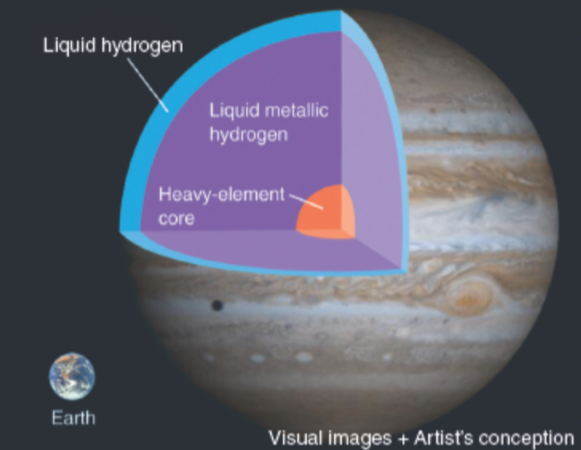Solar System Astronomy
1/196
There's no tags or description
Looks like no tags are added yet.
Name | Mastery | Learn | Test | Matching | Spaced |
|---|
No study sessions yet.
197 Terms
Rotations of planets
all planets revolve around the sun in a counterclockwise motion
nearly all the moons in the solar system orbit their respective planets counterclockwise
most planets’ equators are tipped <30 degrees to their respective orbits
Types of planets
Terrestrial planets
Jovian planets
Terrestrial planets
Small, dense, rocky worlds with little to no atmosphere & no rings
Mercury
Venus
Earth
Mars
Jovian planets
Large, low-density worlds with thick, turbulent atmospheres and liquid/ice interiors
interiors contain small cores of heavy elements surrounded by liquid
have extensive systems of satellites
Have ring systems
Cosmic debris
Asteroids
Kuiper Belt
Comets
Meteors
Asteroids
debris left over from the failure of a planet to form at a distance of ~3 AU from the sun
generally irregular in shape and covered with craters
made up of a variety of rocky & metallic materials
a few show signs of geological activity that probably happened on their surfaces when those asteroids were young
most orbit the Sun in a belt between the orbits of Mars & Jupiter
Kuiper belt
the collection of icy planetesimals that orbit a region from just beyond Neptune out to ~50
Kuiper Belt objects (KBOs): an object in the Kuiper Belt (ex: pluto)
Comets
one of the small, icy bodies that orbit the Sun & produce tails of gas and dust when they’re near the Sun
nuclei of comets are ice-rich bodies a few km-10s of km in diameter
a nucleus remains frozen & inactive while far from the sun
if it comes to the inner Solar System, the Sun’s heat begins to vaporize the ices, releasing gas/dust)
the flow of solar wind & radiation pressure (exerted by sunlight) push gas & dust away, forming a long tail
Meteors
a small bit of matter heated by friction to incandescent Vapor as it falls into Earth’s atmosphere
vapour condenses to form dust that settles slowly to Earth, adding ~40,000 tons per year to our planet’s mass
meteoroid: a meteor in space before it enters Earth’s atmosphere (most are specks of dust, grains of sand or tiny pebbles)
meteorite: a meteor that has survived its passage through the atmosphere & strikes the ground
Determining ages of rock bodies
when a rock solidifies, it incorporates known percentages of the chemical elements (some are isotopes that gradually degrade into other isotopes)
ex: potassium-40 is a parent atom, which decays into the daughter atoms calcium-40 & argon-40
ex: uranium-238 decays with a half-life of 4.5billion years to form lead-206 & other isotopes
ex: rubidium-87 decays into strontium-87 with a half life of 47 billion years
half-life of a radioactive substance: the time required for half of the atoms in a radioactive sample to decay
Radioactive age of rock
the length of time since the material in that rock was last melted
Determining age of the solar system
primary source is meteorites
many meteorite samples have ages of 4.56 billion years old, and is often rounded to 4.6 billion years
Determining age of the sun
uses helioseismological observations & mathematical models of the Sun’s interior
yields a value of ~5 billion years (+/- 1.5 billion years)
History of earthly atoms
By the time the Universe was a few minutes old, the protons, neutrons & electrons in your body had come into existence
they were linked together to form the common atoms today (90% hydrogen, 10% helium)
no atoms heavier than helium were made in the Big Bang
Within a few hundred million years after the Big Bang, matter began to form into galaxies with stars (reactions inside stars are where low-mass atoms are combined to make heavier atoms)
generation after generation of stars cooked original particles, fusing them into atoms such as carbon, nitrogen & oxygen
Calculations indicate that most of the iron on Earth was produced by carbon fusion in type Ia supernova explosions & by the decay of radioactive atoms in the expanding matter ejected by type II supernovae
heavier atoms (gold, silver iodine) are also created by reactions that occur during supernova explosions
Solar nebula theory
the proposal that the planets formed from the same cloud of gas & dust that formed the Sun
The chemical composition of the solar nebula should originally have been roughly the same throughout the disk when it was hot enough to be entirely gas
As the disk cooled down, the inner parts close to the Sun would have had higher temperatures so that only metals and rock could condense there, whereas lots of ices along with metals and rock could condense in the cooler outer parts of the disk, far from the Sun
condensation: the growth of a particle by addition of a material from surrounding gas, one atom or molecule at a time (where the observed pattern of planet densities originated)
condensation sequence: the sequence in which different materials condense from the solar nebula at increasing distances from the Sun
frost line: in the solar nebula, the boundary beyond which water Vapor & other compounds could form ice particles (now separates the region for formation of the Terrestrial planets from that of the Jovian planets)
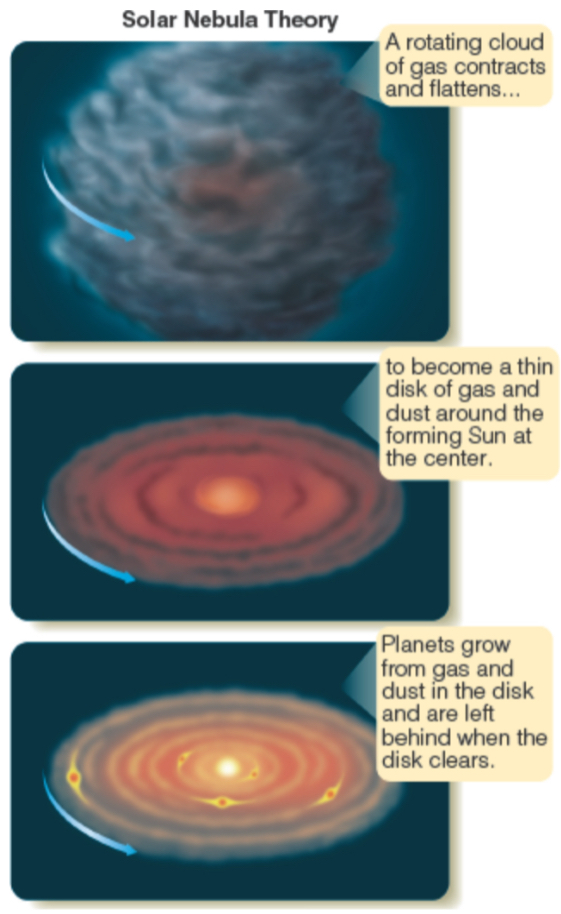
Chemical composition of the solar nebula
the solar nebula was a fragment of an interstellar gas cloud (should have been mostly hydrogen with helium & small amounts of the heavier elements)
since the Sun’s core doesn’t affect the composition of its atmosphere, the composition revealed in the Sun’s spectrum is essentially the composition of gases from which the Sun formed
the Sun is mostly hydrogen, ¼ helium & 2% heavier elements
Uncompressed densities of planets:
the densities the planets would have if their gravity did not compress them
can be calculated from the actual densities & masses of each planet (the closer a planet is to the Sun, the higher its uncompressed density)
Planetesimals
one of the small bodies that formed from the solar nebula and eventually grew into protoplanets
Formation of planetesimals
Condensation: A particle grows by condensation when it adds matter one atom or molecule at a time from a surrounding gas
can increase the mass of a small grain rapidly, but as the grain grows larger, condensation becomes less effective
Accretion: the sticking together of solid particles to produce a larger particle
dust grains in the solar nebula were, on average, less than a meter apart, so they collided frequently and could accrete into larger particles
Growing solid objects would have collected into the plane of the solar nebula while small dust grains could not because of the turbulent motions of the gas
would have concentrated larger solid particles into a relatively thin layer that would’ve allowed further rapid growth (planetesimals don’t collide & combine, but “rub shoulders”)
Gravitational instability: the process of concentrating planetesimals into the plane is analogous to the flattening of a forming galaxy
the rotating disk of particles should’ve been gravitationally unstable and would’ve been disturbed by spiral density waves (waves could’ve further concentrated planetesimals)
Protoplanets
massive object resulting from the coalescence of planetesimals in the solar nebula & destined to become a planet
Formation of protoplanets
Initially grew only by attracting & accumulating solid bits of rock, metal & ice because they did not have enough gravity to capture/hold large amounts of gas
Once a protoplanet approached a size of 15 earth masses, it could begin to grow by gravitational collapse
gravitational collapse: the stage in formation when a planet grows massive enough to begin capturing gas directly from the nebula around it
Heat of formation: the heat released by the infall of matter during the formation of a planetary body
planets also begin to accumulate heat in its interior from the decay of short-lived radioactive elements
these 2 heating sources would’ve eventually have melted the planet and allowed it to differentiate
Differentiation: the separation of planetary material according to density
after a planet melted, the heave metals plus elements chemically attracted to them would settle to the core, while lighter silicates floated to the surface to form a low-density crust
Outgassing: the release of gases from a planet’s interior to create an atmosphere
astronomers hypothesize that some of Earth’s water & atmosphere may have accumulated late in formation as Earth swept up volatile-rich planetesimals, supplementing outgassing (icy planetesimals would have formed in the outer parts of the solar nebula and could have been scattered toward the Terrestrial planets by the gravitational influence of Jovian planets)
Jovian planets would have grown faster than Terrestrial planets and quickly become massive enough to begin even faster growth by gravitational collapse, drawing in large amounts of gas from the solar nebula
would’ve formed before the Sun was hot enough to blow away the gas in the solar nebula

the Jovian Problem
the puzzle that protoplanetary disks around young stars don’t seem to survive long enough to form Jovian planets by condensation, accretion & gravitational collapse, yet Jovian-mass extrasolar planets are common
disks are absorbed from intense UV radiation from hot O and B stars forming nearby (most stars form in clusters containing sibling O & B stars)
Possible answers to the Jovian Problem
direct collapse: the hypothetical process by which a Jovian planet might skip the condensation and accretion of a solid core, instead forming quickly & directly from the gases of the solar nebula
a revised estimate of the opacity of the solar nebula, which was probably much less opaque than the interstellar medium (would’ve allowed the gravitational collapse of nebular material onto the solid proto-Jovian solid cores to proceed much faster than previous models
Hypotheses for Backwards Rotation of Venus
An evolutionary hypothesis: the Sun produced tides in the thick atmosphere of Venus that could’ve eventually reversed the planet’s rotation
A catastrophic hypothesis: the rotation was altered by an impact late in the planet’s formation
Clearing of the Nebula
Radiation pressure: light streaming from the Sun’s photosphere exerted radiation pressure on the particles of the solar nebula
large bits of matter were not affected, but low-mass specks of dust & individual atoms/molecules were driven from the Solar System
medium-mass specks of dust would spiral around the Sun, which would also remove them from the nebula
Solar wind: the flow of ionized hydrogen & other atoms away from the Sun’s upper atmosphere
young stars have even stronger winds, and also irregular fluctuations in luminosity, which can help accelerate the wind
strong surging wind from the young Sun would’ve helped radiation pressure remove dust/gas from the nebula
Sweeping up of space debris by the planets
the heavy bombardment: the period of intense meteorite impacts early in the formation of the planets, when the Solar System was filled with debris (swept up the last of the debris in the solar nebula into the planets)
Ejection of material from the Solar System by close encounters with planets
when a planetesimal’s path passes close to a planet, the small object’s path will be affected from the planet’s gravitational field (may gain enough energy from the planet’s motion to be thrown out of the solar system)
Types of disks
Dense, hot disks forming planets around young stars
sites where planets could be forming right now
Debris disk: cold, low-density disks of dust found around older stars
includes debris from collisions among asteroids, comets & Kuiper Belt objects
most prominent seen from Earth is around the star Beta Pictoris (20x the diameter of our Solar System)
have central zones with lower density in which planets have finished forming and have swept up most of the construction material
Extrasolar planet
a planet orbiting a star other than the Sun
Detecting extrasolar planets
the star will move slightly as it orbits the center of mass of the plant-star system (astronomers can detect a planet orbiting another star by watching how the star moves)
transit: the passage of an extrasolar planet across the disk of its parent star as observed from Earth, partially blocking the light from the star (allowing section)
microlensing: brightening of a background star due to focusing of its light by the gravity of a foreground extrasolar planet, allowing the planet to be detected
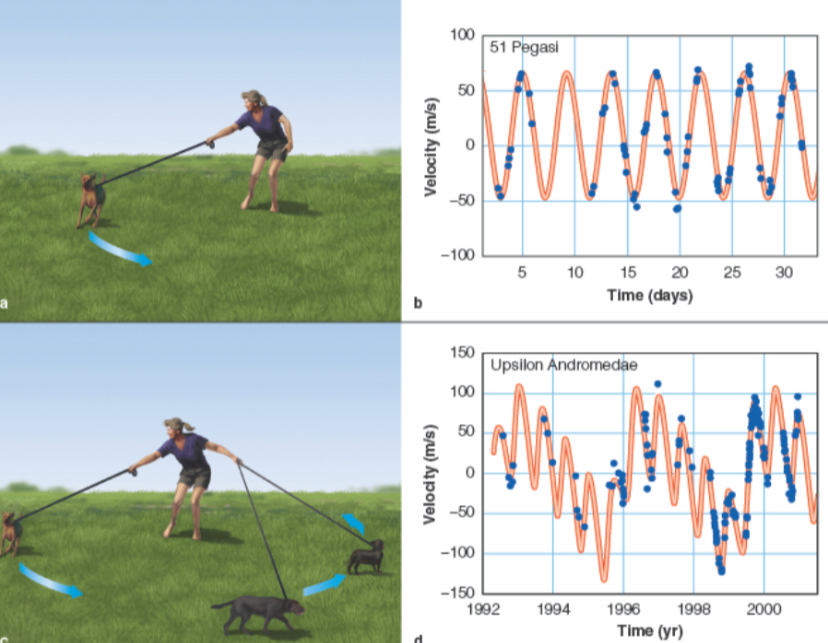
Astrobiology
the field of study involving searches for life on other worlds and investigation of possible habitats for such life
Physical bases of life
carbon & water
because of the way carbon atoms bond to each other and to other atoms, they can join into long, complex table chains capable of storing/transmitting information
takes place in a setting of water
Biological evolution
the combined effect of variation & natural selection resulting in new species arising and existing species adapting to the environment or becoming extinct
natural selection: the process by which the best traits are passed on, allowing the most able to survive
Mutation
offspring born with altered DNA
occur due to external effects during the parent organism’s lifetime
Origin of life on earth
biologists hypothesize that the first living things would have been carbon-chain molecules able to copy themselves
evidence in stromatolites: a layered fossil formation caused by ancient mats of algae or bacteria that build up mineral deposits season after season
remains of colonies of single-celled organisms
found in rocks with radioactive ages of 3.5 billion years
Theories of the origin of life on Earth
primordial soup: the rich solution of organic molecules in Earth’s first oceans (many would’ve been able to link up to form larger molecules, although this would’ve occurred on shorelines where soup concentrations are higher)
molecules may have arrived here from space, as they’ve been found in the interstellar medium, and inside meteorites (harder to test)
Miller-Urey experiment
reproduced the conditions under which life began on Earth and amino acids and other organic compounds were manufactured
consisted of a sterile, sealed glass container holding water, hydrogen, ammonia & methane, thought to resemble the young Earth’s atmosphere
an electric arc inside the apparatus made sparks to simulate effects of lightning
the experiment ran for a week, and found that the interaction between the electric arc & the simulated atmosphere had produced many organic molecules from the raw material of the experiment (includes important building blocks of life such as amino acids)
when the experiment was run again with hot silica to represent molten lava spilling into the ocean, similar molecules were produced
Chemical evolution
the chemical process that led to the growth of complex molecules on the primitive earth (did not involve the reproduction of molecules)
hypothesized that eventually, somewhere in the oceans, a molecule formed that automatically copied itself (as DNA & RNA are able to do)
at this point, natural selection & chemical evolution of molecules became the biological evolution of things
Origins of cells
may have arisen automatically because of the way molecules interact during chemical evolution
the first reproducing molecule that was surrounded by a protective membrane would’ve gained an important survival advantage over other reproducing molecules
the organism that was ancestor to all life on Earth today most closely resembled present-day archaea
Multicellular life forms
an organism composed of many cells
stromatolites & other photosynthetic organisms would have added oxygen to Earth’s early atmosphere, where it would readily combine with iron in the soil (Earth’s surface iron became saturated with oxygen ~2.5 billion years ago)
oxygen metabolism produces much more energy per mass of food than other reactions, and this greater efficiency allowed for the development of multicellular organisms
an oxygen abundance of 0.1% would’ve created an ozone screen, protecting organisms from the sun’s UV radiation
Cambrian explosion
the sudden appearance of complex life forms at the beginning of the Cambrian period 0.5 billion years ago
Cambrian rocks contain the oldest easily identifiable fossils
Extremophile
an organism that can survive in an extreme environment (low/high temps, high acidity, extreme dryness)
thermophile: a type of microorganism that thrives in high-temperature environments (the most likely common ancestor)
Life in our Solar System
many worlds can be eliminated immediately as hosts for water-based life because liquid water isn’t possible there
the moon & mercury are airless so water would boil away into space immediately
Venus has traces of water Vapor in its atmosphere although it’s too hot for liquid water on the surface
Jovian planets have deep atmospheres, and at a certain altitude it is likely water condenses into liquid droplets (do not have solid surfaces, so isolated water droplets cannot mingle)
Jupiter’s moon Europa appears to have a liquid-water ocean below its icy crust, and minerals dissolved in the water could provide a source of raw material for chemical evolution (ocean is kept warm/liquid by tidal heating)
There are liquid-water zones inside Ganymede, Callisto & Saturn’s moon Enceladus (all might have been frozen solid at other times in their histories, which would’ve probably destroyed any living organism that had developed)
Saturn’s moon Titan is rich in organic molecules that could’ve evolved and survived in Titan’s lakes of methane (Titan’s low temp of 96K would make chemical reactions so slow that life processes seem unlikely)
Mars is the most likely place for like to exist in the Solar System as there is a great deal of evidence that liquid water once flowed on its surface (once life is started, biological evolution allows life to spread across the planet and adapt to a wide range of conditions)
Life in other planetary systems
if a planet is to be suitable home for living things, it must be in a stable orbit around its sun
planets in binary star systems would be unstable unless the component stars are very close together or very far apart
in binary systems with stars separated by intermediate distances of AU, the planets should eventually be swallowed up by one of the stars or ejected from the system
stars must last for long periods of time, long enough to allow formation of life
massive stars that shine for only a few million years do not meet this criteria
habitable (goldilocks) zone: the region around a star within which an orbiting planet can have surface temperatures allowing liquid water
a low-luminosity star has a small/narrow habitable zone, whereas a high-luminosity star has a large/wide one
Radio communication
radio signals: electromagnetic waves that travel at the speed of light
anticoded: describes a message designed to be understood by a recipient about whom the sender knows little or nothing (if they are sophisticated enough to build radio telescopes, the hope is that they should be able to decode the transmission)
message is a string of 1679 pulses and gaps.
Pulses represent 1s, and gaps represent 0s.
The string can be arranged in two dimensions in only two possible ways: as 23 rows of 73 or as 73 rows of 23.
The first way produces gibberish, but the second arrangement forms a picture containing information about life on Earth

Water hole
the interval of the radio spectrum between the 21-cm hydrogen radiation & the 18-cm OH radiation (likely wavelengths to use in the search for extraterrestrial life)
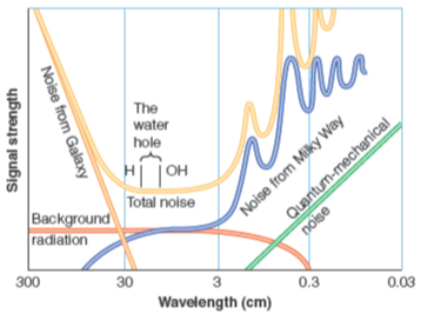
Search for Extra-Terrestrial Intelligence (SETI)
the field of study devoted to searching for extraterrestrial radio signals as evidence of alien intelligence
wider sections of the electromagnetic spectrum being used for Earthly communication, combined with stray electromagnetic radiation from electronic devices makes hearing faint radio signals difficult
Drake equation
a formula for the number of communicative civilizations in our galaxy
NC = the number of technological civilizations in the Milky Way Galaxy with which you might communicate
N* = the number of stars in our galaxy
fP = the fraction of stars that have planets
if all single stars have planets, fP = 0.5
nHZ = the average number of planets in each planetary system suitably located in the habitable zone
fL = the fraction of suitable planets on which life begins
fI = the fraction of fL planets where life evolves to intelligence
fS = the fraction of a star’s life during which an intelligent species is communicative
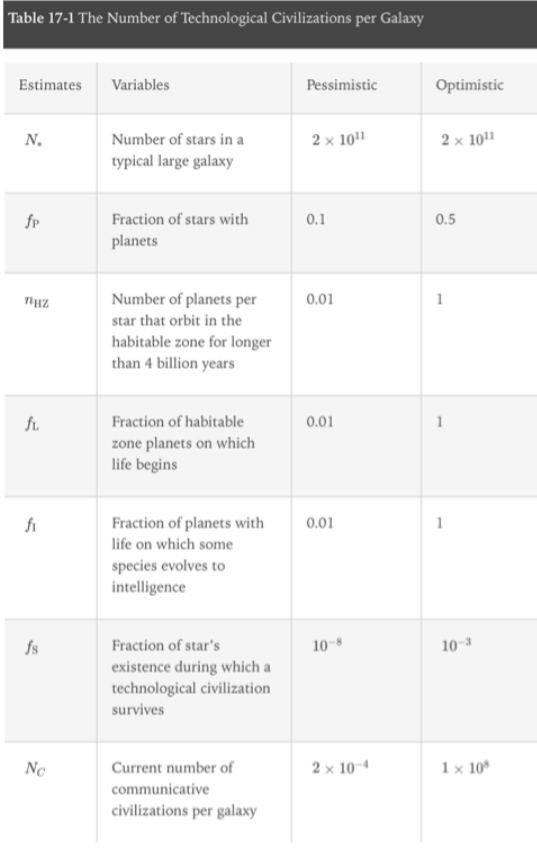
Comparative planetology
the study of planets by comparing the characteristics of different examples
Terrestrial planet composition
differentiated with dense metallic cores surrounded by rocky mantles and low-density crusts on their exteriors
when you see a smooth plain on a planet, you can guess that surface is younger than the heavily cratered areas
Terrestrial atmospheres
Mercury & the moon have little or no atmosphere
Venus is completely hidden by a cloudy atmosphere
Mars has a relatively thin atmosphere
Stages of terrestrial planetary development
all terrestrial planets pass through these stages, but difference in mass. temperature & composition emphasizes some stages over others in different worlds
Differentiation: the separation of material according to density
occurred as a result of the melting of Earth’s interior caused by heat from a combination of radioactive decay plus energy released by infalling matter during the planet’s formation
once the interior of Earth melted, the densest materials were able to sink to the core
Cratering
did not begin until a solid surface formed
the heavy bombardment of the early Solar System made craters on all terrestrial planets (as the debris in the young Solar System cleared away, the rate of cratering impacts fell gradually)
Basin flooding
began as radioactive decay continued to heat Earth’s interior and caused rock to melt in the upper mantle, where the pressure was lower than in the deep interior
some molten rock welled up through cracks in the crust and flooded deeper impact basins
as the environment cooled, water fell as rain and flooded basins for form the first oceans (on earth, basin flooding was first by lava and later by water)
Slow surface evolution
Earth’s surface is constantly changing as sections of crust slide over & against each other, push up mountains & shift continents
moving air & water erode the surface & wear away geological features
Earth’s axis
Tipped 23.4 degree to its orbit
Exploration of Earth’s interior
through seismic waves (a mechanical vibration that travels through Earth; usually caused by an earthquake)
pressure (P) waves: a mechanical wave of compression & rarefaction that travels through Earth’s interior (as a p wave passes, particles of matter vibrate back & forth parallel to the direction of wave travel)
can move through liquid
shear (S) waves: a mechanical wave that travels through Earth’s interior by the vibration of particles perpendicular to the direction of wave travel (distorts material but does not compress it)
can move along the surface of a liquid but not through it
waves reflect boundaries between layers of different density, or may be refracted (scientists use arrival times of reflected & refracted seismic waves from distant earthquakes to construct a model of Earth’s interior)
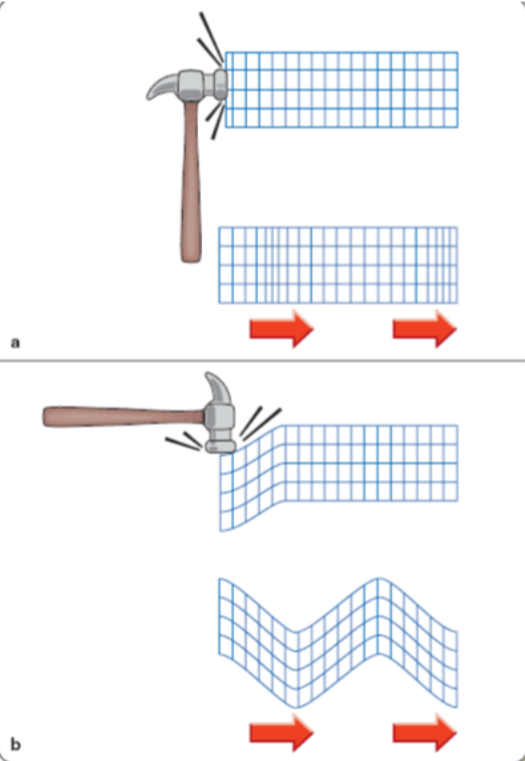
Interior of Earth
3 parts:
Central core (high pressure which raises the melting point so high the material cannot melt)
composed of solid iron & nickel with a radius 22% that of Earth
Thick mantle (behaves like a plastic; most plastic just below earth’s crust)
Thin crust (made up of low-density rocks that float on the denser mantle)
thickest under the continents & thinnest under the oceans

Earth’s magnetic field
a direct result of Earth’s rapid rotation & its molten metallic core (internal heat forces liquid core to circulate with convection)
protects Earth from solar wind
bow shock: the boundary between the undisturbed solar wind & the region being deflected around a planet
magnetosphere: the volume of space around a planet within which the motion of charged particles is dominated by the planetary magnetic field rather than the solar wind
Van Allen belts: one of the radiation belts of high-energy particles trapped in Earth’s magnetosphere (high-energy particles from solar wind leak into the magnetosphere)
Dynamo effect
the rotation of the convecting, conducting liquid generates Earth’s magnetic field
Aurora Borealis
solar wind carries charged particles past Earth’s extended magnetic field, and this generates tremendous electrical currents that flow into Earth’s atmosphere near. The north/south magnetic poles
currents ionize gas atoms in Earth’s atmosphere, and when the ionized atoms capture electrons & recombine, they produce an emission spectrum
Earth’s active crust
Plate tectonics
Continental drift
Composite volcanoes
Shield volcanoes
Earth’s plate tectonics
the constant destruction & renewal of Earth’s surface by the motion of sections. of the crust
where plates spread apart, lava wells up to form new crust; where plates push against each other, they form mountains; where one plate slides over another, you see volcanism
speed is usually slow but plate margins can stick, accumulate stress and then release it suddenly
subduction zone: a region of planetary crust where a tectonic plate slides downward, under another (forms volcanoes)
folded mountain ranges: a long range of mountains formed by the compression of a planets crust (ex: Andes mountains)

Continental drift
currently, the floor of the Atlantic Ocean is locked to the continents and is pushing north & South America away from Europe at about 3cm/year
Composite volcanoes
a volcano built up of layers of lava flows and ash falls (steep sided at 30 degrees)
form above subduction zones where descending crust melts & magma rises to surface
forms chains of volcanoes along the subduction zone
magma is not very fluid
Shield volcanoes
70% of the heat from Earth’s interior flows outward through volcanism along mid-ocean ridges
Origin of Earth’s Atmosphere
thought to have been outgassed during what would have been a planet-wide spasm of violent volcanism (when a volcano erupts, 50-80% of gas released is water vapour, and the rest is carbon dioxide, nitrogen with smaller amounts of sulfur gases)
another hypothesis suggests that the Earth’s atmosphere arrived through bombardment (an early atmosphere rich in carbon dioxide, nitrogen & water vapor would be predicted because the planetesimals combined to build to an Earth rich in those substances)
young atmosphere would’ve been rich in water vapor, carbon dioxide and other gases and as it cooled, water condensed to form the first oceans which absorbed carbon dioxide which reacted with other dissolved substances in the seawater to form mineral sediments
beginning 2 billion years ago, photosynthetic plants in the oceans had multiplied to the point where they made oxygen at a rate faster than chemical reactions could remove it from the atmosphere
Human effects on Earth’s atmosphere
Greenhouse effect: the process by which a carbon dioxide atmosphere traps heat & raises the temperature of a planetary surface
when the ground absorbs sunlight, it grows warmer & radiates at infrared wavelengths
CO2 makes the atmosphere less transparent to infrared radiation, so it is absorbed by the atmosphere and cannot. Escape back into space
Global warming: the gradual increase in the surface of temperature of Earth caused by human modifications to Earth’s atmosphere
the average Earth climate had been cooling for the past 1000 years, but the 20th century reversed that trend
Albedo: the fraction of the light hitting an object that is reflected
Earth’s overall albedo is 0.31, much caused by clouds
Tidal coupling
the locking of the rotation of a body to its revolution around another body
reason why we always see the same side of the moon
Earth’s gravity raises tidal bulges on the Moon, and friction in the bulges has slowed the Moon until it now rotates once each orbit
Moon’s atmosphere
Has an escape velocity too low to keep gas atoms & molecules from departing into space
Shadows near the terminator are sharp & black, indicating there is no air to scatter light & soften shadows
Terminator
the dividing line between daylight & darkness on a planet/moon
Moon’s surface
lunar highlands are filled with jumbled mountains with no folded mountain ranges, showing the moon has no plate tectonics (mountains are pushed up by millions of overlapping impact craters)
lowlands are called maria which are ancient lava flows and are marked by ridges, faults & scattered craters (lava flows happened long ago and were too fluid to build peaks)
sinuous rilles: a narrow, winding valley on the Moon caused by ancient lava flowing along narrow channels
jumbled terrain: disturbed regions of the Moon’s surface opposite the locations of the Imbrium Basin & Mare Orentale (possible focusing of seismic waves from the large impacts)
crust is thinner on the side facing Earth (possibly because of tidal effects)
Cratering of the moon
typical craters is only ⅕-1/10 as deep as its diameter
craters are almost always round because they’re formed by shock waves rushing outward, the rebound of the rock & expansion of hot vapours
ejecta: debris blasted out of a crater (can form bright rays when shout out along specific directions)
secondary craters: a crater formed by the impact of ejecta
micrometeorites: meteorite of microscopic size
multiringed basins: very large impact basin in which there are concentric rings of mountains

Relative age
the age of a geological feature as referred to other features
Absolute age
an age determined in years, as from radioactive dating
Lunar geology
all rock samples from Apollo missions were igneous (formed by cooling & solidification of molten rock)
rocks were extremely dry
rocks from lunar Maria are dark-colored, dense basalts rich in heavy elements such as iron, manganese & titanium (giving them their dark color)
some are vesicular ( contain holes caused by bubbles of gas in the molten rock) showing that they formed in lava flows that reached the surface
radioactively dated 2-4 million years old
are classified as breccias (rocks made up of fragments of earlier rocks cemented together by heat & pressure)
highlands & lowlands are covered by regolith (a soil made up of crushed rock fragments)
10m deep on maria; <100m deep in certain areas of the highlands
1% of regolith is meteoric fragments while the rest is smashed remains of Moon rocks
water in the Moon’s polar region is more likely to have been delivered by comets & other planetesimals rather than being native to the moon
History of the moon
Differentiation: the moon must have formed in a molten state where denser materials sank to form a core, and (as the magma ocean cooled), low-density minerals crystallized and floated to the top to form a low-density crust
Cratering: began as soon as the crust solidified, and was most intense during the first 0.5 billion years (during the heavy bombardment)
cratering level fell rapidly as the Solar System was cleared of debris
lunar crater counts & rock sample ages suggest a late heavy bombardment
Basin flooding: radioactive decay heated material deep in the crust & molten rock followed the cracks up to the surface and flooded the giant basins with successive lava flows of dark basalts
this formed the maria
some craters are irregular shapes because lava overflowed the edges of the basin or because the shape was modified by further cratering
Late heavy bombardment
the surge in cratering impacts in the Solar System that occurred 3.8b years ago
caused by Jupiter & Saturn migrating and temporarily moving into a mutual resonance during which their orbital periods had a 2:1 ratio
the eccentricities of Jupiter’s & Saturn’s orbits would have increased and their gravity would’ve scattered remnant planetesimals into collision with all Solar Systems planets/moons
Origin of Earth’s Moon
Fission hypothesis: proposed the moon broke from a rapidly spinning young Earth
Condensation hypothesis: suggested that the Earth & Moon condensed together from the same cloud of matter in the solar nebula
Capture hypothesis: suggested the Moon formed elsewhere in the solar nebula & was later captured by Earth
Large impact hypothesis: proposes that the Moon formed when a large planetsimal (Theia) smashed into the proto-Earth and the collision ejected a disk of debris into orbit around Earth that quickly formed the Moon (survives comparison with known evidence)
if the colliding planetesimals had already differentiated, ejected material would be mostly mantle & crust (the iron core would combine with the larger body that became Earth)
this explains Moon’s overall low density, why the Mood in so poor in iron & why the abundance of elements are so similar to Earth’s mantle
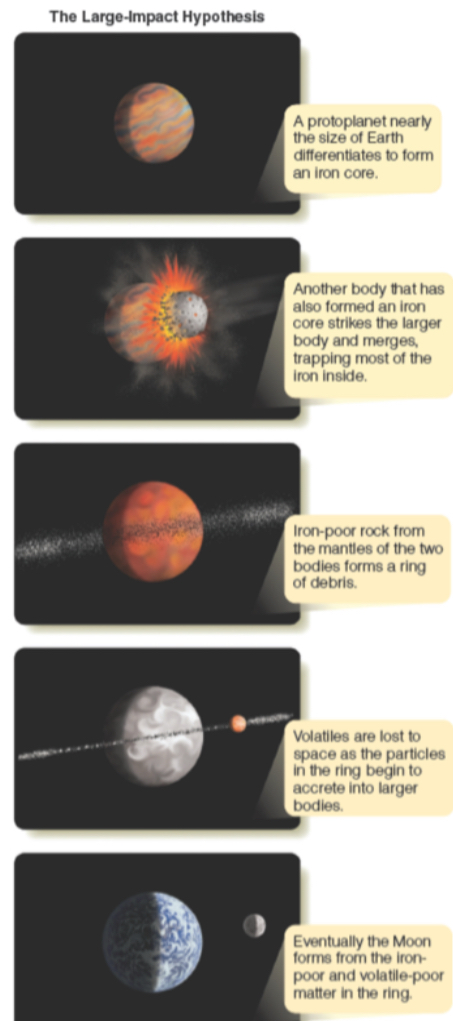
Mercury’s orbit
tidally coupled to the Sun, rotating 1.5x per orbit
in 88 Earth days, Mercury completes one orbit around the Sun
in a 3:2 orbit-rotation resonance (the Sun-Mercury tides slowed the rotation of Mercury and coupled its rotation to its revolution)

Surface of Mercury
temperatures are extreme due to proximity to the sun
heavily battered with craters of all sized (largest basin is Caloris)
marked with lobate scarps (a curved cliff) that were formed with the planet cooled & shrank in diameter, wrinkling its crust
intercrater plains: less heavily cratered terrain (marked by meteorite craters less than 15km in diameter plus secondary craters)
produced by later lava flows during the heavy bombardment
smooth plains: young plains (lava flows that occurred after most cratering had ended)
are not darker than the rest of the crust which may be due to compositional differences in lava flows
Caloris
Mercury’s largest basin (1550km in diameter with concentric mountain rings up to 3km high)
located at one of the two “hot poles” that face the Sun at alternate perihelia
the impact that produced Caloris created peculiar terrain that lies opposite of the Caloris impact
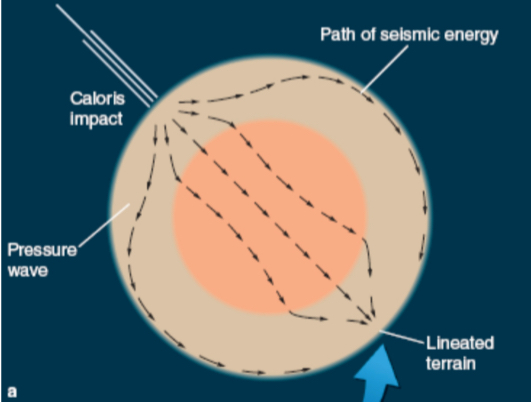
Mercury’s interior
contains a large core of dense metals (mostly iron)
radar observations show the surface is shifting back & forth in response to the Sun’s tidal influences
must mean that at least the outer core is molten (high presence of sulfur lowers the melting point)
heat from gigantic solar flares during Sun’s youth vaproized & drove away rock-forming elements, leading to a larger core & thinner crust on Mercury
History of Mercury
Differentiation
Cratering: occurred over the same period as the cratering on the moon
because of Mercury’s stronger gravity, ejectas aren’t thrown as far & therefore do not blanket as much of the surface
Basin flooding
impact from the Caloris impact fractured the crust & allowed lava flows to resurface wide areas
Surface evolution
limited to micrometeorites, rare larger meteorites & the slow cycle of heat/cold
Venus’s rotation
rotates clockwise (opposite of every other planet in our Solar System other than Uranus) once every 243 Earth days
uniqueness of rotation can be explained by proto-Venus being struck off-center by a large planetesimal
could also be explained by solar tides gradually reversing its rotation when still a terrestrial planet
Venus’s interior
density is the same as earth, indicating a dense metallic interior much like Earth’s (yet no spacecraft has detected a magnetic field around Venus, which would be present. If Venus’s metal core was liquid)
Venus’s atmosphere
96% of the atmosphere is carbon dioxide & 3.5% nitrogen (0.5% water vapor, sulfuric acid, hydrochloric acid & hydrofluoric acid)
Venus’s cloud layers are much higher & more stable than on Earth (highest layer extends 60-70km above the surface)
heated atmosphere at the subsolar point rises & spreads out in the upper atmosphere as convection circulates gas to the dark side of the planet and poles, where it cools & sinks (produces 300-km/hour jet streams in the upper atmosphere moving from east to west)
because Venus rotates slowly, its atmospheric circulation is not broken up into small cyclonic storms but is instead organized as a planet wide wind pattern)
Subsolar point
the point on a planet that is directly below the sun
Water on Venus
scientists hypothesize that the high abundance of deuterium in Venus’ atmosphere (150x Earth’s amount) is the remnant of destroyed water
Venus has no ozone later, so solar UV photons can easily break atmospheric water vapor molecules into hydrogen & oxygen (oxygen forms oxides in the soil and hydrogen leaks into space; heavier deuterium atoms would leak slower than hydrogen atoms, increasing the ratio to deuterium to hydrogen)
Venus currently only has enough water Vapor in its atmosphere to make a planet wide water layer 0.3m deep
Venus’s Greenhouse Effect
explains why Venus is hotter than Mercury even though it’s father from the Sun
96% CO2, which is opaque to infrared radiation, causes temperatures hot enough to melt lead
thick atmosphere & high winds carry heat around the planet so surface temperatures are nearly the same everywhere
cause: when Venus was young, it may have been cooler but because it was formed 30% closer to the Sun than Earth, it was always warmer than Earth leading to the runaway greenhouse effect
Runaway greenhouse effect
a positive feedback loop in which a planet’s greenhouse effect causes enhanced release or retention of GHGs that increase the greenhouse effect, and so on
Earth & Venus should have outgassed about the same amount of CO2, but Earth’s oceans have dissolved most of Earth’s CO2 and converted it into sediments
Venus’s surface
most of the surface consists of low, rolling plains (large-scale lava flows) & highland regions (regions of deformed crust)
rocks seem to be basalt (a typical product of volcanism)
1000 impact craters (more craters than Earth)
uniformly scattered and look fresh (due to no water & a slow-moving lower atmosphere causing little erosion)
thick atmosphere protects surface from small meteorites
lava channels are common on Venus, appearing similar to the sinuous rills visible on the Moon
does not have true plate tectonics (due to low density, dryness & pliability of Venus’s crustal rocks)
Venus’s low-density crust is more buoyant than Earth’s and would resist being pushed into the interior
lack of water imbedded in rocks and therefore lubrication, Venus’s crustal rocks would not slide past each other easily
Venus’s crust is halfway to its melting point, making it not stiff and unable to form the rigid plates typical of plate tectonics
Volcanism of Venus
shield volcano: wide, low-profile volcanic cone produced by highly liquid lava
formed by highly fluid lava that flows easily and creates low-profile peaks with slopes of 3-10 degrees
volcanism over a hot spot results in repeated eruptions that build up a shield volcano of many layers
coronae: circular bulges up to 2000km in diameter containing volcanic peaks & lava flows (caused by rising currents of molten magma below the surface that uplifted the crust and then withdrew
sometimes accompanied by pancake domes (solidified outpourings of lava)
History of Venus
Venus & Earth formed in the same way and outgassed atmospheres rich in CO2 as they differentiated into dense cores & less dense mantles/crusts
Venus might have had oceans when it was young, but because Venus is closer to the Sun than Earth, it was initially warmer, so substantial amounts of water would have evaporated, increasing the greenhouse effect which dried up any oceans and severely reduced ability of Venus to clear its atmosphere of CO2
as more CO2 was outgassed, the greenhouse effect grew even more severe and eventually solar UV radiation destroyed atmospheric water Vapor, leaving an overabundance of deuterium
Venus’s numerous volcanoes are insufficient to carry most of the heat out of the interior. Rather, Venus gets rid of interior heat through large convection currents of hot magma that rise beneath the crust
same currents deform the surface to create cornea and such structures
features such as the folded mountains provide evidence of limited horizontal crustal motion, although most geological processes seem to be vertical rather than horizontal
Small number of craters indicates the entire crust has been replaced within the past half-billion years or so
May have occurred in a planet wide overturning as the old crust broke up and sank and lava flows created a new crust
Mars’s orbit, rotation & axis
1 day is 24 hours 40 minutes long
1 year is 1.88 Earth years
tipped 25.2 degrees to its orbit (almost exactly as Earth)
has seasons with about the same winter-summer contrast as earth
Interior of Mars
soon after Mars formed it had a liquid metallic core in which the dynamo effect generated a magnetic field strong enough to magnetize surface rocks (has no overall magnetic field, but does have traces of magnetism frozen into sections of old crust)
Mars has a very dense core, a less dense mantle & a low-density crust
evidence that Mars is differentiated comes from Doppler-shift measurements of radio signals allowing scientists to map the gravitational field and study the shape of Mars including tides in the body caused by Sun’s gravity
because of size, it lost its heat rapidly and most of its core gradually froze solid (may be why the dynamo finally shut down)
today, Mars probably has a large solid core surrounded by a shell of liquid metal that is too thin for the dynamo effect to be able to generate a magnetic field
ices in the polar caps are frozen CO2 with frozen water underne
Mars’s atmosphere
air is 95% CO2, with a few percent each of nitrogen & argon (argon is evidence that there once was a denser blanket of air)
reddish color of soil is caused by oxides (meaning the oxygen humans need is locked in chemical compounds in the soil)
without an ozone layer, UV photons from the Sun can penetrate deep into the atmosphere and break up water molecules allowing hydrogen to escape and the oxygen to form oxides
density at the surface is only 1% that of Earth’s (does not provide enough pressure to prevent liquid water from boiling into Vapor; water can only exist as ice or Vapor)
winds can be strong enough to produce dust storms that envelop the entire planet
with little atmosphere, solar wind may have removed much of the gas over its lifetime (earlier magnetic field may have limited this effect)
Water on Mars
Viking spacecraft photos indicated water once flowed on Mars
Outflow channels: appears to have been caused by sudden flooding
Valley networks: dry drainage channels resembling stream beds
Mars Reconnaissance Orbiter photographed eroded remains of a river delta in an unnamed crater in ancient highlands (indicated that the river flowed for long periods of time, shifting its channel to form meanders and braided channels)
levels of deuterium (5.5x more abundant than normal hydrogen) suggests Mars once had 20x more water than now (much has been broken up by solar UV radiation)
there is enough water at the planet’s south polar region to cover the entire planet to a depth of 11m
History of Mars
Noachian period (4.3 - 3.7 billion years ago): the geological era that extends from the formation of the crust to the end of heavy cratering and includes the formation of the valley networks
crust was battered by heavy bombardment (the old southern hemisphere survived from this period)
no trace of magnetic field (dynamo had shut down by then)
included flooding by great lava flows that smoothed some regions
volcanism in the Tharsis & Elysium regions was very active (Tharsis grew into a huge bulge on the side of Mars)
valley networks were formed when water fell as rain or snow and drained down slopes
required a higher temperature & higher atmospheric pressure (volcanism could have vented gases, including more water Vapor to keep air pressure high)
original planetwide magnetic field may have protected atmosphere from solar wind
Hesperian period (3.7-3 billion years ago): the geological era from the decline of heave cratering & lava flows and the melting of subsurface ice to form the outflow channels
massive lava flows covered some sections of the surface
most outflow channels date from this period, suggesting the loss of atmosphere drove Mars to become a cold desert world (when volcanic heat/large impacts melted subsurface ice, the water could have produced violent floods that shaped the channels)
Mars once had a rotation axis of 45 degrees, resulting in a generally warmer climate that kept more CO2 from freezing out at poles (rise of Tharsis could have tipped axis to its present 25 degrees)
Amazonian period: the geological era from 3 billion years ago to present, marked by low-level cratering, wind erosion & small amounts of water seeping from subsurface ice
planet lost much of its internal heat, and core no longer generates a global magnetic field
crust is too thick to be active with plate tectonics and therefore has no folded mountain ranges on Mars
volcanism may occur occasionally, but the crust has grown too thick for much geological activity
Mars’s Moons
tidally locked to Mars, keeping the same side facing the planet as they orbit
revolve around Mars in the same direction that Mars rotates
albedos 0.07, making them look dark
low densities
properties suggest they’re captured asteroids scattered by bodies such as Jupiter throughout the Solar System
heavy battering broke them into irregular chunks & cannot pull themselves into smooth spheres because their gravity is too weak
Phobos
One of Mars’s moons
Shaped like a potato measuring 28x23x20km in size
Contains a set of narrow, parallel grooves (hypothesized that they’re deep fractures produced by the impact that formed its larger crater)
Cools quickly, suggesting it’s covered with a very fine dust (at least 1m deep)
Deimos
One of Mars’s moons
16x12x10km in size
Covered with a thicker layer of surface dust
Jovian planets
Hydrogen-rich atmospheres filled with clouds
Belt-zone circulation: the atmospheric circulation that produces dark belts and bright zones encircling the planet parallel to its equator (much less distinct on Uranus & Neptune)
Have giant circulating storms
Not very deep

Jovian planet moons
Regular satellites: a moon with an orbit that has small eccentricity, low inclination to the equator of its parent planet, and is prograde
thought to have formed with their planets rather than having been captured
prograde: rotation or revolution in the direction with most motions in the Solar System
Irregular satellites: a moon with an orbit that has large eccentricity or high inclination to the equator of its parents planet or moves in retrograde
thought to have been captured
Jupiter’s interior
mostly liquid hydrogen containing small amounts of heavier elements
pressure & temperature are higher than the critical point for hydrogen, meaning there’s no difference between gaseous hydrogen & liquid hydrogen
¼ of the way to the center, the pressure is high enough to force hydrogen into being liquid metallic hydrogen
much of the heavy metals (⅓) is suspended in the convectively stirred liquid hydrogen (rest are included in a heavy-element core)
center is 5-6x hotter than the surface of the Sun
